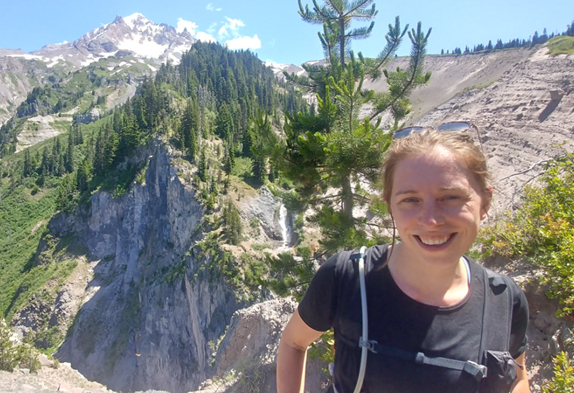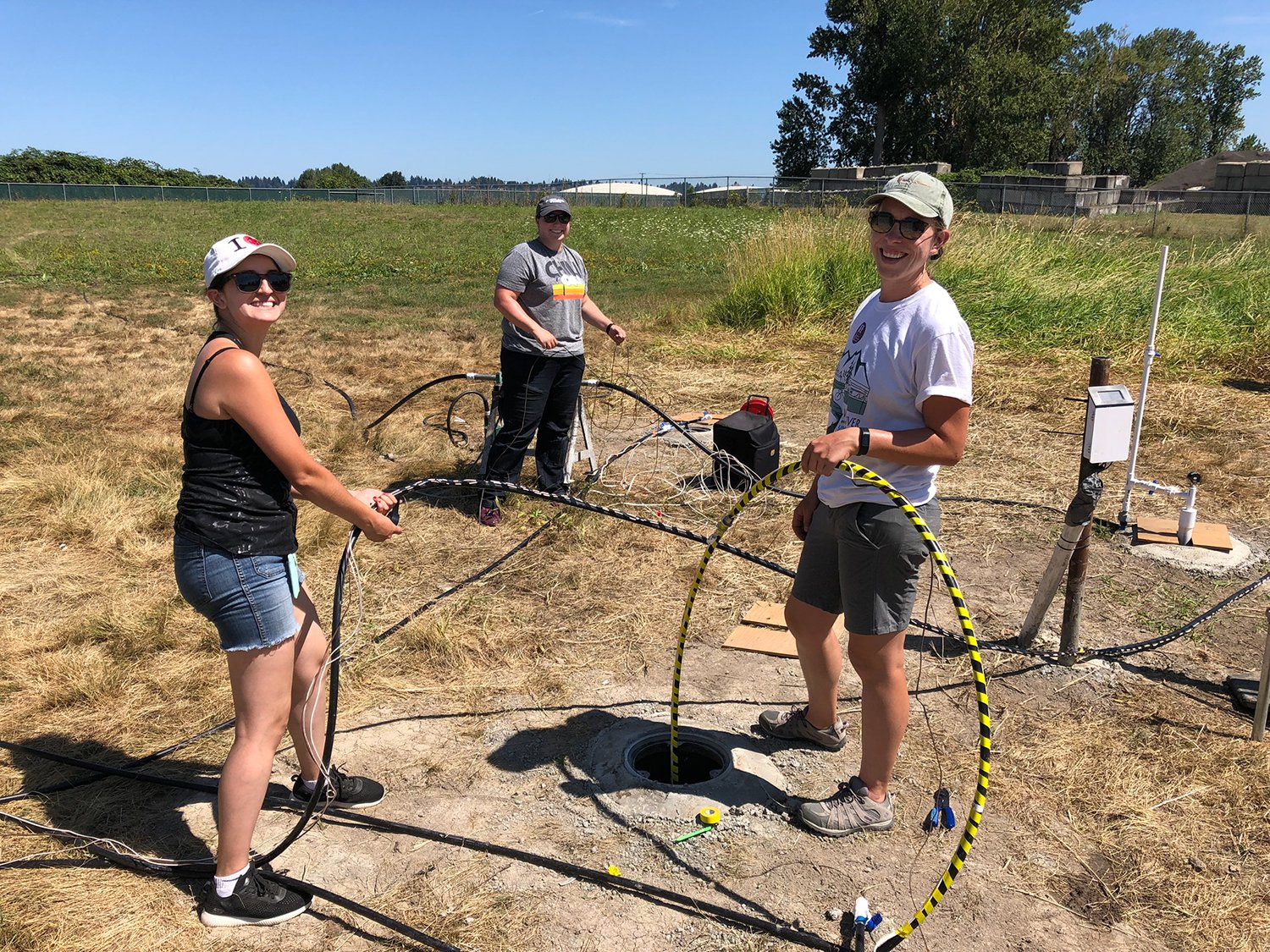Geotech Research to Advance Knowledge of Hazard-Prone Soils
Experiments at NHERI UC Davis to improve cone penetration testing, site investigation practice
Published on July 24, 2024
Geotechnical engineer Diane Moug has an interest in unique, problematic, and poorly characterized soils. An assistant professor at Portland State University, Moug recently received a U.S. National Science Foundation CAREER Award to focus on geotechnical site investigation, particularly for poorly understood soils by way of the cone penetration test, a standard tool for geotechnical engineers. She is conducting CPT modeling at the UC Davis Center for Geotechnical Modeling, a facility in the NSF Natural Hazard Engineering Research Infrastructure network, NHERI.
Securing soils in the Pacific Northwest
Much of Moug’s research is driven by the earthquake hazard endemic to the Pacific Northwest, where the Cascadia Subduction Zone runs parallel to the coastline for 600 miles. Experts worry that a large, destructive earthquake could occur along this fault at any time.

“The idea is to advance the CPT test — to better inform engineers who use it, and to expand the scope of the engineering properties and behaviors that can be interpreted from CPT data.”
Diane Moug
Assistant Professor
Portland State University
Compounding the region’s earthquake hazard is the nature of its soils, Moug says. “There are a lot fine-grained soils and silt for which we do not have extensive data and case histories regarding their behavior during an earthquake.”
Even more worrisome, 90% of Oregon’s liquid-fuel supply, the state’s Critical Energy Infrastructure hub, is situated on liquefaction-prone ground along the Willamette River. “There are a number of critical structures in Portland that were built before our understanding of the region’s seismic hazard and that we do not believe will withstand a large earthquake,” she explains.
In geotechnical circles, Moug is known for her work using microbially induced desaturation, or MID, to remediate liquefaction-prone soils – especially soils beneath and around existing structures. The MID method for geotechnical engineering was pioneered at the NSF Center for Bio-mediated and Bio-inspired Geotechnics at Arizona State University. The technique works by promoting the growth of gas-producing bacteria in soil. This biologic process desaturates the soil particles and reduces the potential for earthquake-triggered liquefaction.
Validating the efficacy MID for hazard mitigation requires time, Moug reminds us. “We treated a research site, the Sunderland site, during field trials in 2019. We continue to investigate how effective MID is for mitigating liquefaction, especially in fine-grained soils. We are monitoring and collecting data to determine if the technique is effective, and if so, how long it lasts,” she says.
This ongoing NSF-funded MID project is a combination of lab and field work conducted by Moug and colleagues from PSU, Arizona State University, and the University of Maine.

Diane Moug, right, with PSU graduate students at the Sunderland field research site in Portland.
Dealing with uncertainties
Moug recently received the prestigious NSF CAREER award, which she is using to focus on improving site investigation for poorly understood soils, including those found in the PNW region. At the NHERI UC Davis large centrifuge facility, Moug is conducting basic research that will help practicing geotechnical engineers by expanding and improving the capabilities of the cone penetration test (CPT) and geotechnical site investigation programs. Moug earned her PhD at UC Davis, so it is a homecoming of sorts.
Geotechnical engineers use the CPT to characterize soils in their site investigations. Simple and accurate, the test involves inserting a cone-tipped probe into the ground at a constant rate. The probe’s sensors measure cone tip resistance, side frictional resistance, and pore water pressure. All combined, this data indicates the soil type and some engineering properties.
Unfortunately, Moug says, there are many engineering properties or soil types for which we cannot confidently interpret CPT data.
“I want to fill in the gaps for soils that we don’t have good guidance on, and for soils we do not have CPT data for – unique soils or soils that are not well covered in that database. The idea is to advance the CPT test – to better inform engineers who use it, and to expand the scope of the engineering properties and behaviors that can be interpreted from CPT data,” Moug says.
She calls her work uncertainty-informed site investigation.

Image credit: Paul Mayne, Georgia Tech
“I’m looking to develop an uncertainty-based framework that would allow engineers to consider: given the current knowledge you have at the site — this is the range of soil properties you can expect and the associated uncertainty. And if you invest in additional site investigation, this is how your uncertainty reduces and how design can change.”
Having a better grasp of a site’s design properties directly affects a project’s structural design and construction costs, Moug explains. When geotechnical engineers understand the value of conducting additional site investigations – further testing, drilling, sampling – they can better understand how the additional investigation will propagate to affect the cost of the whole project.
In terms of the CPT itself, she wants to develop a more fundamental understanding of the soil behavior around the cone. “We want to understand just how the soil is responding based on the soil properties itself. And how that then translates into the data that we get from the cone’s sensor readouts,” she adds.

Earthquake liquefaction susceptibility of Oregon's Critical Energy Infrastructure Hub. Image: Dusicka, Moug, et al.
“I expect to find a fundamental basis for interpreting cone data that could be used across soil types.”
Diane Moug
Assistant Professor
Portland State University
Geotechnical centrifuge modeling
At the NHERI UC Davis Center for Geotechnical Modeling, Moug is conducting cone penetration modeling using the 9-meter geotechnical centrifuge; the centrifuge bucket has been fitted with deeper, specially devised container for CPT soil tests.
“Under controlled conditions, with specific soils, we will get a sense of what the CPT data will be for a given soil type. And when we change those conditions, we’ll see how the CPT data respond.”
She’ll look at a variety of soils and conditions, study the cone data readouts — and then combine that information with numerical modeling of the cone going through soil, as well as with lab data.
Currently, geotechnical engineers can rely on CPT data for sand-like soil and for clay-like soil.
“But there are so many other soils,” Moug says. “There are silts and silty sands. There’s crushable sand, like calcareous sands, or pumice sands. Or sands with some cement between the particles. I expect to find a fundamental basis for interpreting cone data that could be used across soil types.”
Basic research, practical applications
Clearly, Diane Moug is dedicated to solving real-world problems, a common approach among geotechnical engineers.
“In geotech engineering, we like to say that we are engineering and dealing with things as they are, not as we wish they were. So I like the idea of working with problems that exist in the natural world, and dealing with natural hazards or landforms as they are. Which means you must also deal with uncertainty – because you don’t entirely know what exists below the ground.”
One thing is certain however: Moug’s fundamental research will lead to better, more complete soil characterizations and improve the practice of geotechnical engineering.





